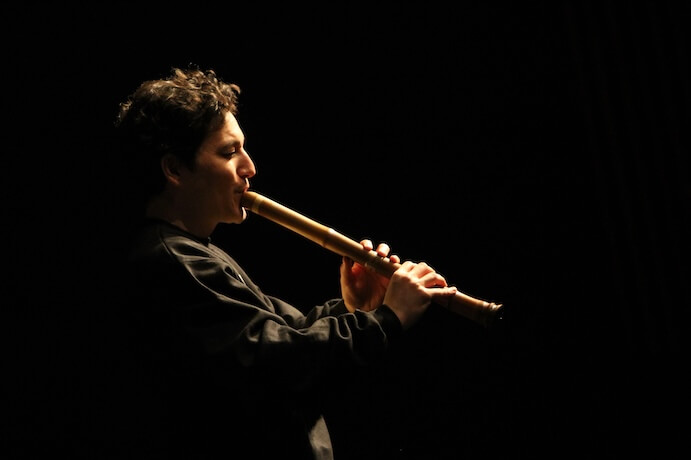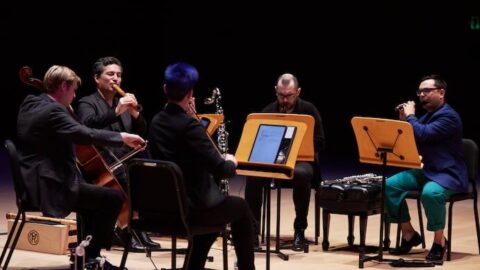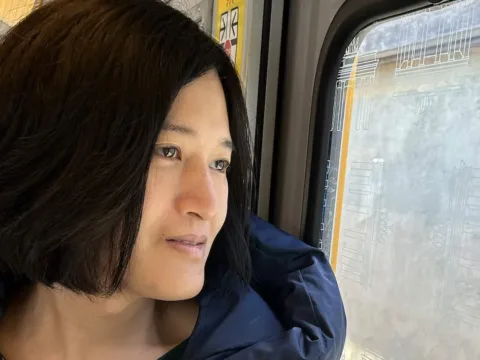At the conceptual core of a distance, intertwined is the notion of storytelling, with traditional folkloric approaches contrasted with more abstract modern modes. Out June 7 on In A Circle Records, the album is the culmination of a long-established partnership between Hub New Music, Tokyo-born shakuhachi soloist Kojiro Umezaki, and the Asia-America New Music Institute, featuring debut recordings by Umezaki, Takuma Itoh, Chad Cannon, SunYoung Park, and Angel Lam.
The album’s title is derived from a major work of the Noh Theater repertoire, entitled Takasago (高砂), and was chosen to unify the different approaches taken by each composer into a single narrative thread. As the story of Takasago goes, there was a priest who departed from Mount Aso, traveling by land, river, and sea on a trip to the capital city. Upon his arrival, he encountered a pair of evergreen trees in human form — a married couple — who shared a fantastical connection; their roots were impossibly intertwined, despite being planted a full day’s journey apart. By some supernatural means, they had collapsed time and space to be together, and under the moonlight, offered a celebration of life that traverses human generations — a distance, intertwined.
From the first moments of Takuma Itoh’s Faded Aura, the austere imagery of an ancient Japanese pine grove is easy to conjure. A familiar, breathy gesture from the lone shakuhachi instills an echo of nostalgia, informed perhaps by my own taste in classic records on labels such as Windham Hill and ECM that often juxtaposed new and old, folk and classical, and the amalgamation of various cultural traditions under the expansive category of “New Age.”

While a sense of oldness presents itself through the sonority of the shakuhachi, there is a very current musical language being spoken in Itoh’s piece and throughout the rest of the album. The sylvan lilt of Umezaki’s shakuhachi pitted against the sparkling, silvery tones of Michael Avitabile’s flute, the wooden buzz from violinist Meg Rohrer and cellist Jesse Christeson, and the full throated melancholy of Gleb Kanasevich’s clarinet create a luscious and detailed harmonic landscape rife with adventures for the listener.
Chad Cannon’s Death Masks recasts the shakuhachi as a journeying spirit, liberated from its former body, whose face has been cast in plaster as a memento for the living. The work opens in solemnity, perhaps a dirge commemorating the departed, and develops across cadenza-like breaks taken by the shakuhachi into a kinetic danse macabre performed as an improvisatory duet between shakuhachi and flute. In this section, Umezaki and Avitabile’s tightly spun performance effectively blurs the line between these flute cousins, putting equal measures of technical accomplishment on display.

Umezaki follows a superb performance in Cannon’s piece by adding composer to his role. His composition, Tied Together by Twilight is an examination of the many dialectical tensions he has observed in contemporary Japan; younger vs. older generations, modern vs. traditional life, urban vs. rural, female vs. male, divinity vs. humanity and linear vs. non-linear time. Umezaki elegantly dictates these themes with sultry, middle-voiced cadenzas on his shakuhachi, suspended over delicate and spacious pizzicato textures and long, legato countermelodies in the clarinet and flute. There is a broad sense of stillness to this work that effectively expresses the notion of rapid progress laid over an unshakable foundation of ancient culture and tradition.
Moonlight by SunYoung Park returns to the fantastical realm of Japanese folklore with a series of scenes inspired by The Tale of the Bamboo Cutter (竹取物語), a story popularized by the Oscar-nominated 2013 Studio Ghibli film adaptation, The Tale of the Princess Kaguya (かぐや姫の物語). Park’s setting follows Princess Kaguya as she attempts to return to her people in the heavens, while the denizens of the earth try to stop her. Kaguya is represented by pensive and elegantly woeful statements from the shakuhachi. At odds with this song of longing are angular, disruptive statements from the rest of the ensemble, which represent the objections of her earthbound adversaries.
Finally, in the furthest departure from the acoustic world of the album, Angel Lam’s three-movement Whispers of Sea Rivers adds spoken word and collages of pre-recorded sounds to support a whimsical story that is narrated by the composer. At first I found the sudden din of recorded sounds somewhat arresting; audio of passing cars, the distant jabbering of a television broadcast, and announcements from a train platform all dissolve into a drone of crashing surf before the narrator enters in tandem with the ensemble. Textured, chordal music accompanying the narrator’s story of returning home to the “fragrant harbor” is a fitting conclusion to the album, exemplifying the development of new perspectives while planting and preserving one’s roots in tradition.
a distance, intertwined is filled with beautiful, haunting music that presents a clear and authentic dialog between varied cultural paradigms and traditions. Each composer’s unique voice offers a special synthesis of contrasts and similarities between musical cultures, separated by distance, but intertwined by common threads of creative spirit.
I CARE IF YOU LISTEN is an editorially-independent program of the American Composers Forum, and is made possible thanks to generous donor and institutional support. Opinions expressed are solely those of the author and may not represent the views of ICIYL or ACF.
You can support the work of ICIYL with a tax-deductible gift to ACF. For more on ACF, visit the “At ACF” section or composersforum.org.
























